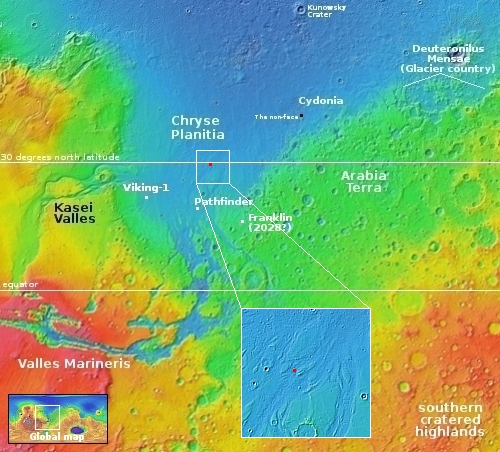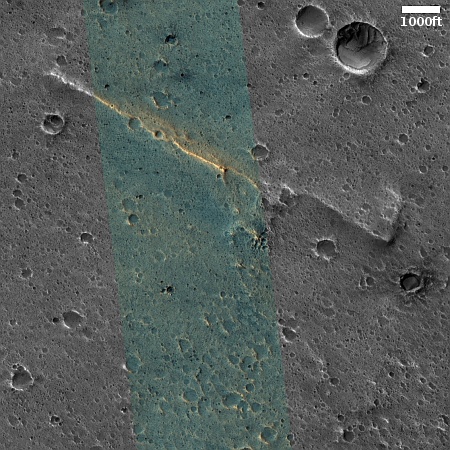Ridge in Martian lowland plains
Today’s cool image is interesting not because it shows us some spectacular Martian terrain, but because the most distinct feature is a thin ridge only a few feet high that pokes up out of the northern lowland plains for apparently no reason.
The picture to the right, cropped, reduced, and sharpened to post here, was taken on July 1, 2023 by the high resolution camera on Mars Reconnaissance Orbiter (MRO). The ridge is about 1.8 miles long, and is only about five feet high on its western end, rising to about 25 feet on its eastern end.
The colors differences indicate that the ridge’s peak is likely bedrock, and the surrounding greenish/blue hue suggesting sand and rocks covered with dust. The ridge might be the top of a deeper buried topological feature but that is only a guess.

The red dot in the inset near the center of the overview map to the right marks this location. This tiny ridge sits just south of 30 degrees north latitude, which is generally the dividing line between the increasingly icy polar regions and the Martian dry equatorial tropics. There might be near surface ice here, but if so it is also likely deeper or of lower quantity.
The ground here is part of the drainage from the theorized catastrophic floods that are believed to have poured out of Valles Marineris in the distant past. If so, those floods hit this ridge at right angles. In fact, the image might even show us the aftereffects of that impact. The ridge appears broken near its center, as if that rush of water pushed through.
All guesses of course, likely wrong. We must also remember that no model as yet been developed that reasonably makes flowing liquid water even possible on the surface of Mars. The atmosphere was always either too thin or cold.
On Christmas Eve 1968 three Americans became the first humans to visit another world. What they did to celebrate was unexpected and profound, and will be remembered throughout all human history. Genesis: the Story of Apollo 8, Robert Zimmerman's classic history of humanity's first journey to another world, tells that story, and it is now available as both an ebook and an audiobook, both with a foreword by Valerie Anders and a new introduction by Robert Zimmerman.
The print edition can be purchased at Amazon or from any other book seller. If you want an autographed copy the price is $60 for the hardback and $45 for the paperback, plus $8 shipping for each. Go here for purchasing details. The ebook is available everywhere for $5.99 (before discount) at amazon, or direct from my ebook publisher, ebookit. If you buy it from ebookit you don't support the big tech companies and the author gets a bigger cut much sooner.
The audiobook is also available at all these vendors, and is also free with a 30-day trial membership to Audible.
"Not simply about one mission, [Genesis] is also the history of America's quest for the moon... Zimmerman has done a masterful job of tying disparate events together into a solid account of one of America's greatest human triumphs."--San Antonio Express-News
Today’s cool image is interesting not because it shows us some spectacular Martian terrain, but because the most distinct feature is a thin ridge only a few feet high that pokes up out of the northern lowland plains for apparently no reason.
The picture to the right, cropped, reduced, and sharpened to post here, was taken on July 1, 2023 by the high resolution camera on Mars Reconnaissance Orbiter (MRO). The ridge is about 1.8 miles long, and is only about five feet high on its western end, rising to about 25 feet on its eastern end.
The colors differences indicate that the ridge’s peak is likely bedrock, and the surrounding greenish/blue hue suggesting sand and rocks covered with dust. The ridge might be the top of a deeper buried topological feature but that is only a guess.

The red dot in the inset near the center of the overview map to the right marks this location. This tiny ridge sits just south of 30 degrees north latitude, which is generally the dividing line between the increasingly icy polar regions and the Martian dry equatorial tropics. There might be near surface ice here, but if so it is also likely deeper or of lower quantity.
The ground here is part of the drainage from the theorized catastrophic floods that are believed to have poured out of Valles Marineris in the distant past. If so, those floods hit this ridge at right angles. In fact, the image might even show us the aftereffects of that impact. The ridge appears broken near its center, as if that rush of water pushed through.
All guesses of course, likely wrong. We must also remember that no model as yet been developed that reasonably makes flowing liquid water even possible on the surface of Mars. The atmosphere was always either too thin or cold.
On Christmas Eve 1968 three Americans became the first humans to visit another world. What they did to celebrate was unexpected and profound, and will be remembered throughout all human history. Genesis: the Story of Apollo 8, Robert Zimmerman's classic history of humanity's first journey to another world, tells that story, and it is now available as both an ebook and an audiobook, both with a foreword by Valerie Anders and a new introduction by Robert Zimmerman.
The print edition can be purchased at Amazon or from any other book seller. If you want an autographed copy the price is $60 for the hardback and $45 for the paperback, plus $8 shipping for each. Go here for purchasing details. The ebook is available everywhere for $5.99 (before discount) at amazon, or direct from my ebook publisher, ebookit. If you buy it from ebookit you don't support the big tech companies and the author gets a bigger cut much sooner.
The audiobook is also available at all these vendors, and is also free with a 30-day trial membership to Audible.
"Not simply about one mission, [Genesis] is also the history of America's quest for the moon... Zimmerman has done a masterful job of tying disparate events together into a solid account of one of America's greatest human triumphs."--San Antonio Express-News



Again, thank you for not only the images, but also of the mysteries they show.
Are we doing this anywhere else? The spacecraft doesn’t seem _that_ large at about a ton.
Maybe when SLS gets cancelled (it really is just a matter of time), we can spend that money throwing these things across the solar system.
markedup2 asked, “Are we doing this anywhere else?”
Assuming you are asking about other orbiters around other planets, the answer these days is, generally no. Juno is in orbit around Jupiter, but its camera is low resolution and the mission is not focused at imaging the planet. We presently have no orbiters taking images at Mercury, Venus, Saturn or beyond. And the other Mars orbiters don’t take images with the high resolution of MRO.